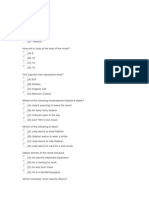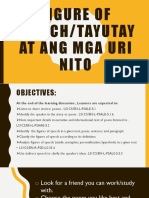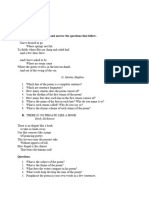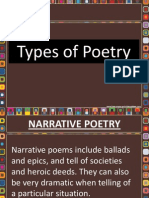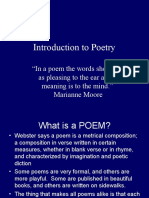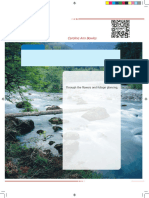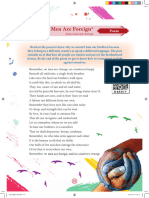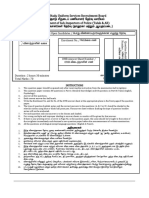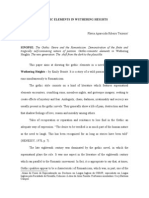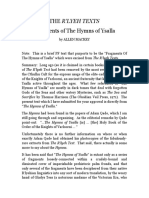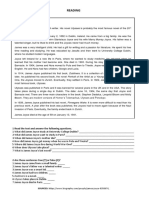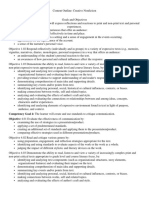From A Railway Carriage
From A Railway Carriage
Uploaded by
subufb1Copyright:
Available Formats
From A Railway Carriage
From A Railway Carriage
Uploaded by
subufb1Original Title
Copyright
Available Formats
Share this document
Did you find this document useful?
Is this content inappropriate?
Copyright:
Available Formats
From A Railway Carriage
From A Railway Carriage
Uploaded by
subufb1Copyright:
Available Formats
www.tntextbooks.
in
Poem
From A Railway Carriage
WARM UP
Read the title.
• What do you think the poem is about?
• Have you been on a train?
• Close your eyes and think about the moving scene outside a train window.
• Take turns in class to describe one image that crossed your mind.
eg. I saw a tea vendor run past the window; I saw tall trees flash past...
Faster than fairies, faster than witches,
Bridges and houses, hedges and ditches;
And charging along like troops in a battle,
All through the meadows the horses and cattle:
All of the sights of the hill and the plain
Fly as thick as driving rain;
And ever again, in the wink of an eye,
Painted stations whistle by.
Here is a child who clambers and scrambles,
All by himself and gathering brambles;
Here is a tramp who stands and gazes;
And there is the green for stringing the daisies!
Here is a cart run away in the road,
Lumping along with man and load;
And here is a mill and there is a river:
Each a glimpse and gone forever!
- Robert Louis Stevenson
Robert Louis Balfour Stevenson (13 Nov 1850 – 3 December 1894) was a
Scottish novelist, poet, essayist, musician and travel writer. His famous works are
‘Treasure Island’, ‘Kidnapped’, ‘Strange Case of Dr. Jekyll & Mr. Hyde’ and ‘A Child’s
Garden of Verses’.
128
6th_2nd_Term_English_Unit_2.indd 128 11-07-2018 19:39:56
www.tntextbooks.in
GLOSSARY
Charge - To make a rush at or sudden attack upon a person or thing
Clamber - Climb or move in an awkward and laborious way using both hands and feet
Brambles - A prickly scrambling shrub of the rose family especially a blackberry
Tramp - A person who travels from place to place on foot in search of work or as
a beggar
Stringing - Hang so that it stretches in a long line
Lumping - Carry with difficulty
Glimpse - See or perceive briefly or partially
READ AND UNDERSTAND
A. Read the lines and answer the questions given below.
1. Faster than fairies, faster than witches,
Bridges and houses, hedges and ditches;
a. What is faster than fairies and witches?
b. Why does the poet mention ‘bridges and houses, hedges and ditches’? Where are they?
2. Here is a child who clambers and scrambles,
All by himself and gathering brambles;
a. Where do you think the child is?
b. What does ‘gathering brambles’ mean?
3. And ever again, in the wink of an eye,
Painted stations whistle by.
a. ‘In the wink of an eye’ means very quickly. Explain ‘painted stations whistle by’.
4. Each a glimpse and gone forever;
a. What is ‘each’ over here? Why is it gone forever?
B. Answer the following questions.
1. What does ‘charges along like troops in a battle’ mean?
2. What word could best replace ‘charges’ in the poem - marches, rushes or pushes?
3. Why does the child clamber and scramble?
129
6th_2nd_Term_English_Unit_2.indd 129 11-07-2018 19:39:57
www.tntextbooks.in
C. Think and Write.
1. Write a paragraph about 50 words describing the scenes that the poet passed by.
2. There is a connection between the rhyming words and rhythms of the train. Present
your views about it.
D. Fill in the blanks to complete the summary.
Ever since their introduction, ___________, and their unique rhythms have
___________ poets. In this poem the poet shares his experience ___________
with us. He presents natural scenes seen from __________ a railway carriage. The
___________ is regular and steady but ___________ from the window of the train is
constantly changing. The poem’s rhythm and phrases bring ___________ of a railway
journey. The poet looks out of the window at the ___________ images outside. Every
line we see here is a quick account of something seen for ___________. The line that
best sums up is the final one: "Each a glimpse and gone forever!"
VOCABULARY
E. Find me in the poem.
1. I can help you to cross the river - .
2. I can border your garden - .
3. I can alert you - .
4. I can carry you - .
5. You can ride on me - .
6. You can climb on men - .
7. You can lay down on me - .
8. You can play with me - .
APPRECIATING THE POEM
F. Work in pairs.
A simile is a figure of speech that directly compares two things. Similes explicitly
use connecting words such as ‘like’ and ‘as’.
eg. ‘as cool as’; ‘like a child’.
1. Discuss with your partner and pick out the similes used in the poem. Which one do
you like the most? Why?
2. Discuss with your partner and pick out the rhyming words from the poem.
130
6th_2nd_Term_English_Unit_2.indd 130 11-07-2018 19:40:00
You might also like
- Language UniversalsDocument5 pagesLanguage UniversalsFlavia PachecoNo ratings yet
- Teza Engleza Clasa A 11 ADocument3 pagesTeza Engleza Clasa A 11 ALauryFely67% (3)
- The Red PonyDocument9 pagesThe Red PonyFaysal JemaiNo ratings yet
- From A Railway CourageDocument4 pagesFrom A Railway CourageSenthil MadhuNo ratings yet
- YJC - 2008 H2 EN Prelim Paper 1Document9 pagesYJC - 2008 H2 EN Prelim Paper 1SNo ratings yet
- Eng Week 4 Day 1Document32 pagesEng Week 4 Day 1JOHN JOMIL RAGASANo ratings yet
- From A Railway CarriageDocument3 pagesFrom A Railway CarriageAntara DasNo ratings yet
- Steve 11a3-31 PoemDocument7 pagesSteve 11a3-31 PoemSteve Nathaniel GideonoNo ratings yet
- Figure of Speech (Autosaved)Document19 pagesFigure of Speech (Autosaved)CHILLY ANN D. ALSONGNo ratings yet
- Leisure - Zeenat GaziDocument37 pagesLeisure - Zeenat GaziZest SpiritNo ratings yet
- NCERT Books For Class 3 English Chapter 6Document11 pagesNCERT Books For Class 3 English Chapter 6Alisha PaulNo ratings yet
- A Narrow Fellow in The GrassDocument5 pagesA Narrow Fellow in The GrassFitri DelitaNo ratings yet
- LiteratureDocument76 pagesLiteratureMhel FelicesNo ratings yet
- Reading Poetry 1Document38 pagesReading Poetry 1Myriel Jean LuigNo ratings yet
- 21st Century Literature - 2nd Quarter ExamDocument2 pages21st Century Literature - 2nd Quarter ExamRonelynHernandezAblanida0% (1)
- G11 - Literature - 2nd Quarter - Set BDocument2 pagesG11 - Literature - 2nd Quarter - Set BRonelynHernandezAblanidaNo ratings yet
- Poetic DevicesDocument26 pagesPoetic DevicesSafiya IslamNo ratings yet
- Five Poems For KidsDocument12 pagesFive Poems For KidsCiorcasNo ratings yet
- Exam 21STDocument2 pagesExam 21STjohnjaxevanNo ratings yet
- Name: - ClassDocument46 pagesName: - ClassKaiden Grant [STUDENT]No ratings yet
- Short Coursework: Literary Devices of PoemDocument13 pagesShort Coursework: Literary Devices of Poemrhijau_3No ratings yet
- Poems From Love That DogDocument11 pagesPoems From Love That Dogjonathan.freinbergNo ratings yet
- 5 Elements of A Short StoryDocument37 pages5 Elements of A Short StoryJosh RoxasNo ratings yet
- Literary DevicesDocument40 pagesLiterary DevicesArlinationNo ratings yet
- Poetry For StudentsDocument42 pagesPoetry For StudentsAdriansyah KatiliNo ratings yet
- Poetry Term PPTDocument33 pagesPoetry Term PPTraelamNo ratings yet
- 3437853021Document6 pages3437853021Satkaran TamberNo ratings yet
- Gonzales Darius R. ESEN 0113 - MODULE 3 CP 04 - Strategies For Reading Creative Texts TOPIC 1: Appreciating Poetry Pre-AssessmentDocument3 pagesGonzales Darius R. ESEN 0113 - MODULE 3 CP 04 - Strategies For Reading Creative Texts TOPIC 1: Appreciating Poetry Pre-AssessmentMingNo ratings yet
- Thorns, Horns, and Crescent Moons: Reading and Writing Nature PoemsFrom EverandThorns, Horns, and Crescent Moons: Reading and Writing Nature PoemsNo ratings yet
- Introduction To Poetry: Poetic Devices & TermsDocument34 pagesIntroduction To Poetry: Poetic Devices & TermsVERNA A GASTONNo ratings yet
- RymaDocument4 pagesRymaSMA MUHAMMADIYAH SALAMANNo ratings yet
- Week 4, English 8 LoveDocument12 pagesWeek 4, English 8 LoveKobe BryNo ratings yet
- English Q3 W1Document11 pagesEnglish Q3 W1Rosie ParkNo ratings yet
- Rhyme: Example: Brat, Fat, Mat, SatDocument33 pagesRhyme: Example: Brat, Fat, Mat, SatGuy Minecraft100% (1)
- TAALS Literature GenresDocument43 pagesTAALS Literature GenresChristine Del RosarioNo ratings yet
- Poetry BookletDocument15 pagesPoetry Bookletsamarth.sharma6411No ratings yet
- The Circle GameDocument3 pagesThe Circle GamemslenihanNo ratings yet
- Assessment: Compilation of Answers in Module Week 1-7-HUM 112 Module 1: Imagery, Diction, and Figures of SpeechDocument10 pagesAssessment: Compilation of Answers in Module Week 1-7-HUM 112 Module 1: Imagery, Diction, and Figures of SpeechBlack PinkNo ratings yet
- Department of Education: Sonnet 116 A. Abab CDCD Efef GG By: William Shakespeare B. Abcd CDCD Efef GGDocument4 pagesDepartment of Education: Sonnet 116 A. Abab CDCD Efef GG By: William Shakespeare B. Abcd CDCD Efef GGLoida AustialNo ratings yet
- Introduction To Poetry: Presented By: Hussam MohammedDocument52 pagesIntroduction To Poetry: Presented By: Hussam MohammeddaekmmmmNo ratings yet
- Narrative Writing Step by StepDocument15 pagesNarrative Writing Step by StepSafa TariqNo ratings yet
- Types of PoetryDocument21 pagesTypes of PoetryMildred Viray Datu100% (2)
- TAALS - Literature GenresDocument102 pagesTAALS - Literature GenresChristine Del RosarioNo ratings yet
- Textual Analysis BookletDocument12 pagesTextual Analysis BookletAnjana AgnihotriNo ratings yet
- Department of Education (Deped)Document6 pagesDepartment of Education (Deped)MARIAN TIMTIMANNo ratings yet
- Poetry 5 FPacket 5 F7 TH 5 FgradeDocument23 pagesPoetry 5 FPacket 5 F7 TH 5 FgradeTomas UrretaNo ratings yet
- 26 - Using Figures of Seech Grade6Document11 pages26 - Using Figures of Seech Grade6Gie Escoto Ocampo100% (1)
- Cls Assignment 243Document16 pagesCls Assignment 243zairieNo ratings yet
- A Tragic StoryDocument3 pagesA Tragic StorySenthil MadhuNo ratings yet
- LiteratureDocument63 pagesLiteratureKyleigh SaculingganNo ratings yet
- FIGURATIVE LANGUAGE WORKSHEET Bima Adi NugrahaDocument2 pagesFIGURATIVE LANGUAGE WORKSHEET Bima Adi NugrahaBima AdiNo ratings yet
- Private Lesson - PoemDocument9 pagesPrivate Lesson - PoemMaria Guan LoretoNo ratings yet
- English Revision Worksheet Class 7Document13 pagesEnglish Revision Worksheet Class 7tanisharahulmishraNo ratings yet
- PoetryDocument42 pagesPoetrysubhash1988No ratings yet
- Intro To Poetry 1Document51 pagesIntro To Poetry 1Aneel100% (1)
- Elements of PoetryDocument20 pagesElements of PoetryAbeer Kabbag100% (1)
- Namma Kalvi 12th English Poem Study Material 216574 1Document8 pagesNamma Kalvi 12th English Poem Study Material 216574 1Babusung7No ratings yet
- Class - 3 English Lesson - 2 - 21640Document9 pagesClass - 3 English Lesson - 2 - 21640Garima Maheshwari123No ratings yet
- Introduction To Poetry & Icarus FlightDocument42 pagesIntroduction To Poetry & Icarus FlightDALAL HATTAN100% (1)
- Introduction To Poetry: Poetic Devices & TermsDocument34 pagesIntroduction To Poetry: Poetic Devices & TermsT StoreNo ratings yet
- Wa0073.Document9 pagesWa0073.nikhil.khamaru4531No ratings yet
- Youtube Test - 03Document24 pagesYoutube Test - 03subufb1No ratings yet
- I Am Every WomenDocument3 pagesI Am Every Womensubufb1No ratings yet
- The Stick TogetherDocument5 pagesThe Stick Togethersubufb1No ratings yet
- Mensuration 2DDocument100 pagesMensuration 2Dsubufb1No ratings yet
- Stooping by WoodsDocument4 pagesStooping by Woodssubufb1No ratings yet
- The RiverDocument4 pagesThe Riversubufb1No ratings yet
- The CometDocument5 pagesThe Cometsubufb1No ratings yet
- Your SpaceDocument5 pagesYour Spacesubufb1No ratings yet
- The Spider and The FlyDocument5 pagesThe Spider and The Flysubufb1No ratings yet
- Making Life Worth WhileDocument3 pagesMaking Life Worth Whilesubufb1No ratings yet
- Special HeroDocument4 pagesSpecial Herosubufb1No ratings yet
- No Men Aer ForeignDocument4 pagesNo Men Aer Foreignsubufb1No ratings yet
- Secret of The MachineDocument5 pagesSecret of The Machinesubufb1No ratings yet
- Sea FeverDocument4 pagesSea Feversubufb1No ratings yet
- A Stargic StoryDocument3 pagesA Stargic Storysubufb1No ratings yet
- COURAGEDocument4 pagesCOURAGEsubufb1No ratings yet
- Salute Test - 11 Answer KeyDocument22 pagesSalute Test - 11 Answer Keysubufb1No ratings yet
- Tamil Eligible Test - 9Document10 pagesTamil Eligible Test - 9subufb1No ratings yet
- Salute Test - 10Document21 pagesSalute Test - 10subufb1No ratings yet
- Salute Test - 6Document22 pagesSalute Test - 6subufb1No ratings yet
- Salute Test - 8 (Revision - 2)Document21 pagesSalute Test - 8 (Revision - 2)subufb1No ratings yet
- Salute Test - 5Document9 pagesSalute Test - 5subufb1No ratings yet
- Salute Test - 7 - Answer KeyDocument22 pagesSalute Test - 7 - Answer Keysubufb1No ratings yet
- Modern Fiction: Rajat Kumar ENH/16/045 Motilal Nehru College Delhi UniversityDocument2 pagesModern Fiction: Rajat Kumar ENH/16/045 Motilal Nehru College Delhi UniversityRajat KumarNo ratings yet
- UntitleddocumentDocument3 pagesUntitleddocumentapi-330353475No ratings yet
- 303 Sarah Rhetorical Analysis 3Document7 pages303 Sarah Rhetorical Analysis 3Sarah King100% (1)
- I. Key Traits of A Character: 1. Della - The Gift of The MagiDocument3 pagesI. Key Traits of A Character: 1. Della - The Gift of The MagiMa Minh HươngNo ratings yet
- English ENTRANCE EXAM PRACTICE QUESTIONS FOR GRADE 7Document3 pagesEnglish ENTRANCE EXAM PRACTICE QUESTIONS FOR GRADE 7Angel Mae A. CarcuevaNo ratings yet
- Middle Eastern and African LiteratureDocument3 pagesMiddle Eastern and African LiteratureDiana CalderonNo ratings yet
- Gothic Elements in Wuthering HeightsDocument0 pagesGothic Elements in Wuthering HeightsShama Abbasi100% (2)
- An Idela HusbandDocument3 pagesAn Idela HusbandRAFAEL GONZALEZ ROJASNo ratings yet
- Common Sense in English For PSLE StudentsDocument53 pagesCommon Sense in English For PSLE StudentsCantoro Joe0% (1)
- List of Books Worth Reading - SummaryDocument4 pagesList of Books Worth Reading - SummaryankushpolNo ratings yet
- Descriptive Writing QuestionsDocument5 pagesDescriptive Writing QuestionsKatniss100% (3)
- Keats and HellenismDocument2 pagesKeats and Hellenismswayamdiptadas22No ratings yet
- Greco Egyptian Magical PapyriDocument4 pagesGreco Egyptian Magical PapyriBrant0% (1)
- A Line of Poetry That Has 12 SyllablesDocument2 pagesA Line of Poetry That Has 12 SyllablesNatalie0% (2)
- Close ReadingDocument7 pagesClose ReadingAnonymous nMdgq4No ratings yet
- Angeles University Foundation: September 2008 New Acquisitions ListDocument7 pagesAngeles University Foundation: September 2008 New Acquisitions Listauflibrary1341100% (1)
- Ad Herennium Rhetorica by SimonidesDocument510 pagesAd Herennium Rhetorica by SimonidesFelipe Vlz MjaNo ratings yet
- Astrology For Beginners - An Easy Guide To Understanding & Interpreting Your Chart (Hewitt)Document146 pagesAstrology For Beginners - An Easy Guide To Understanding & Interpreting Your Chart (Hewitt)Sabina Serban100% (6)
- The R'Lyeh Text - The Hymns of Ysalla by Allen MackeyDocument7 pagesThe R'Lyeh Text - The Hymns of Ysalla by Allen MackeyALLEN MACKEYNo ratings yet
- Quotes From HootDocument3 pagesQuotes From HootAni Coca KollaNo ratings yet
- Chapter IV RevisedDocument20 pagesChapter IV RevisedJayward BacoNo ratings yet
- For The World's Greatest Roleplaying Game: An Anthology of Seventeen Mystery-Themed AdventuresDocument17 pagesFor The World's Greatest Roleplaying Game: An Anthology of Seventeen Mystery-Themed AdventuresAlan Mateo Escobar Agudelo29% (7)
- w5 6 Summative Test With AkDocument3 pagesw5 6 Summative Test With AkCarizza SiasonNo ratings yet
- James Joyce: ReadingDocument2 pagesJames Joyce: ReadingKaren ParraNo ratings yet
- CNF OutlineDocument10 pagesCNF OutlineilonahNo ratings yet
- The Role of Cinema and Art in Shaping Communities. Andrei ZAPSADocument4 pagesThe Role of Cinema and Art in Shaping Communities. Andrei ZAPSAAndrei GS ZapshaNo ratings yet
- Percy SledgeDocument9 pagesPercy SledgeKrisdaryadiHadisubrotoNo ratings yet


